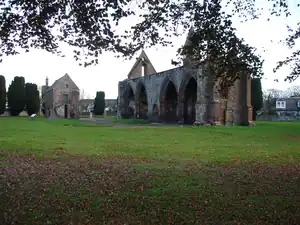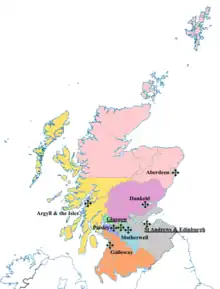
The Bishop of Ross was the ecclesiastical head of the Diocese of Ross, one of Scotland's 13 medieval bishoprics. The first recorded bishop appears in the late 7th century as a witness to Adomnán of Iona's Cáin Adomnáin. The bishopric was based at the settlement of Rosemarkie until the mid-13th century, afterwards being moved to nearby Fortrose and Fortrose Cathedral. As far as the evidence goes, this bishopric was the oldest of all bishoprics north of the Forth, and was perhaps the only Pictish bishopric until the 9th century. Indeed, the Cáin Adomnáin indicates that in the reign of Bruide mac Der Ilei, king of the Picts, the bishop of Rosemarkie was the only significant figure in Pictland other than the king. The bishopric is located conveniently close to the heartland of Fortriu, being just across the water from Moray.
However, in the High and Later Middle Ages, the bishopric was only of medium-to-low status in the Scottish church. The Bishopric's links with Rome ceased to exist after the Scottish Reformation, but continued, saving temporary abolition between 1638 and 1661, under the episcopal Church of Scotland until the Revolution of 1688. Episcopacy in the established church in Scotland was permanently abolished in 1689.
List of known bishops and abbots of Ross maic Bairend
| Tenure | Incumbent | Notes |
|---|---|---|
| fl. 690x710 | Curetán | Later named or conflated with St Boniface. He is listed as one of the witnesses in the Cáin Adomnáin, where he is called "Curetan epscop". In the Martyrology of Tallaght he is called "of Ross Mand Bairend" and in the Martyrology of O'Gorman he is styled "bishop and abbot of Ross maic Bairend". It is modern histiography that places this location at Rosemarkie in the Black Isle, Ross. |
List of known bishops of Ross
| Tenure | Incumbent | Notes |
|---|---|---|
| fl. 1127 x 1131 | Mac Bethad of Rosemarkie | |
| fl. 1147 x 1151-1155 | Symeon of Rosemarkie | |
| 1161-1195 | Gregoir of Rosemarkie | |
| 1195-1213 | Reinald Macer | Former monk of Melrose Abbey. |
| 1213 x 1214 | Andreas de Moravia | Was elected, but got permission from the Pope to resign. |
| 1214-1249 | Robert (elder) | |
| 1249-1271 | Robert (younger) | |
| 1272-1274 | Matthew | |
| 1275-1292 x 1295 | Robert de Fyvie | |
| 1292 x 1295-1295 | Adam de Darlington | After the death of Bishop Robert (III.) de Fyvie, both Adam, precentor of Ross, and Thomas de Dundee were elected to the see. "Master Adam" voyaged to Rome resigned his claim in Thomas' favour; became Bishop of Caithness in the following year. |
| 1293 x 1295-1325 | Thomas de Dundee | |
| 1325-1350 | Roger | Perhaps the same as Roger de Balnebrich, unsuccessful Bishop-elect of Dunblane. |
| 1350-1371 | Alexander Stewart | |
| 1371-1398 | Alexander de Kylwos | |
| 1398-1416 x 1418 | Alexander de Waghorn | |
| 1416 x 1418 | Thomas Lyell | It appears that, although he appears briefly in the sources as "Bishop elect", he never appears to have been consecrated, namely because Avignon Pope Benedict XIII had reserved the see for his own appointment. |
| 1418-1422 | Gruffydd Young | Anti-Bishop during schism. Welshman, formerly Bishop of Bangor. Never obtained possession, but retained title until made titular Bishop of Hippo. |
| 1418-1439 x 1440 | John Bullock | |
| 1440-1441 | Andrew Munro | Previously, Archdeacon of Ross. He had been postulated by the chapter, but despite great expense and effort, Pope Eugene IV disallowed the postulation and appointed the bishopric to Thomas de Tulloch. |
| 1440-1460 x 1461 | Thomas de Tulloch | |
| 1461-1476 | Henry Cockburn | |
| 1476-1480x1481 | John Woodman | |
| 1481-1483 | William Elphinstone | Was provided by Pope Sixtus IV, but in 1483 was translated to the Bishopric of Aberdeen. |
| 1483-1488 x 1492 | Thomas Hay | |
| 1492-1492 x 1494 | John Guthrie | |
| 1497-1507 | John Fraser | |
| 1507-1524 | Robert Cockburn | Translated to bishopric of Dunkeld in 1524. |
| 1523-1538 | James Hay | |
| 1538-1545 | Robert Cairncross | |
| 1547-1558 | David Panter | |
| 1558-1565 | Henry Sinclair | |
| 1566-1568/73/92 | John Lesley | Most famous bishop of Ross, because of his work as a historian. He was forfeited on 19 August 1568 (though still acting as bishop in 1573) for his catholic and Marian sympathies by the Scottish church, but had his position reaffirmed by the Papacy. He was rehabilitated as Bishop between March 1587 and May 1589. He was translated as the Bishop of Coutances in 1592. Died 31 May 1596. |
| 1574-1578 | Alexander Hepburn | See above. |
| 1600-1613 | David Lindsay | |
| 1613-1633 | Patrick Lindsay | Became Archbishop of Glasgow. |
| 1633-1638 | John Maxwell | Episcopacy abolished in December 1638. Maxwell became Bishop of Killala and Achonry in 1641 and Archbishop of Tuam in 1645. |
| 1662-1679 | John Paterson | First bishop in the "Restoration Episcopate". |
| 1679-1684 | Alexander Young | Previously Bishop of Edinburgh. Died 1684. |
| 1684-1689 | James Ramsay | Previously Bishop of Dunblane. Deprived of his see with the Abolition of Episcopacy in the Church of Scotland, 22 July 1689. |
References
- Anderson, Alan Orr, Early Sources of Scottish History: AD 500–1286, 2 Vols, (Edinburgh, 1922), vol. i
- Dowden, John, The Bishops of Scotland, ed. J. Maitland Thomson, (Glasgow, 1912)
- Keith, Robert, An Historical Catalogue of the Scottish Bishops: Down to the Year 1688, (London, 1824)
- Lawrie, Sir Archibald, Early Scottish Charters Prior to A.D. 1153, (Glasgow, 1905)
- Watt, D. E. R., Fasti Ecclesiae Scotinanae Medii Aevi ad annum 1638, 2nd Draft, (St Andrews, 1969)
